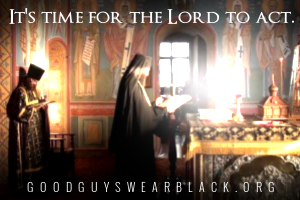![Moses cruciform]](https://preachersinstitute.com/wp-content/uploads/2014/08/Moses-cruciform.jpg)
by Fr. Patrick Henry Reardon
Arguably the most notable intercessor in the Hebrew Bible is Moses. Gregory the Dialoguist, in a letter to Augustine of Canterbury (shortly after the arrival of the Roman missionaries to England), wrote at length of this ministry of Moses. The text must be abbreviated to its most salient points:
“Further, there occurs to my mind, while I think on these things, what took place with one servant of God, even one eminently chosen. . . . Fasting forty days and nights in Mount Sinai, he received the tables of the law; among lightning and thunder, while all the people trembled, he was attached to the service of Almighty God, being alone with Him even in familiar converse; he opened a way through the Red Sea; he had a pillar of a cloud to lead him on his journey; to hungry people he gave manna from heaven . . Whenever a doubtful matter had troubled his mind, he resorted to the tabernacle, and enquired of the Lord in secret, and was forthwith taught concerning it, God speaking to him. When the Lord was angry with the people, he appeased Him by the intervention of his prayer.”
First among the passages showing Moses as an intercessor is the second half of Exodus 17. This text describes Moses’ prayer for the army of Israel as it did battle with the Amalekites. Moses, having commanded Joshua to lead his force, ascended a hill, taking with him Aaron and Hur. Lifting his hands, Moses prayed for Israel’s victory over its enemy in the field below. His prayer was prolonged. It happened, says Exodus, that
“when Moses held up his hands, Israel prevailed; and when he let down his hands, Amalek prevailed. But Moses’ hands became heavy; so they took a stone and put it under him, and he sat on it. And Aaron and Hur supported his hands, one on one side, and the other on the other side; and his hands were steady until the going down of the sun.”
Although the text does not explicitly say that Moses was praying, virtually all Jewish and Christian readers through the centuries have understood the scene this way; the elevation of his hands symbolized the elevation of the mind toward heaven. Josephus, for example, indicates this with the comment,
“Moses stretched out his hand towards heaven.”
Indeed, the Mishna sees in Moses here a model of spiritual elevation:
“Could the hands of Moses help or hinder the battle? This teaches you, rather, that the Israelites prevailed when they directed their thoughts on high and preserved their hearts subject to their Father in heaven; otherwise they suffered defeat.”
Judaism’s great medieval commentator Rashi follows the same interpretive line:
“Moses was such that his hands expressed faith (veyihi yadaiv ‘amunah), spread forth to heaven in a steadfast and firm prayer.”
Christian readers followed suit. Thus, Theodoret of Cyr wrote,
“Great Moses, even as an old man, as he spread his hand in prayer, vanquished Amalek”.
And Jerome:
“When Moses fought against Amalek, it was with prayer, not the sword, that he prevailed.”
The posture of Aaron and Hur to Moses’ sides suggests that his arms were raised in cruciform. This detail was sufficient for Christians to perceive in Moses an image of Christ praying on the Cross. Thus, Tertullian wrote,
“we not only raise our hands, we spread them out and, taking our model from the Lord’s Passion, we confess Christ in prayer.”
This imagery prompted Epiphanius to declare,
“Amalek has been destroyed, root and branch, and the trophy of the Cross was erected on the hill of Rephidim.”
Moses conquered the Devil, wrote Gregory the Theologian,
“by stretching out his hands upon the hill, in order that the Cross, thus symbolized and prefigured, might prevail.”
St. Gregory elsewhere speaks of Aaron and Hur
“supporting the hands of Moses on the hill where Amalek was defeated by the Cross.”
By the Mysteries of the Church, he commented,
“Amalek will be destroyed, not with weapons, but with the opposing hands of the righteous man, expressing both prayer and the unconquerable trophy of the Cross.”
Saint Ambrose observed how effortless Moses’ prayer appeared, while his two companions supported his arms. He was so leisured, wrote Ambrose,
“that others held up his hands. Still, he was no less active than the others, for even with his hands at rest he was overcoming the enemy, whom those on the battlefield were unable to defeat.”
